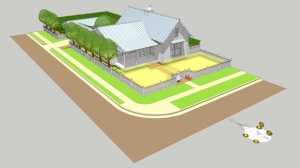A Placemaking Journal
Dancing with Urban Agriculture
My lovely wife of eight years enjoys really bad television. For better or worse, last night she tricked me into watching a segment of ‘Dancing with the Stars.’ Coyly, she asked me to name the movies in which the dancing ‘star’ had ‘starred’.
Having no idea and starting my way back upstairs, I heard her mimicking quietly, “Bueller… Bueller…?

Surprisingly, this now unrecognizable star from my beloved ’80s was Jennifer Grey, of Dirty Dancing and Ferris Bueller fame. I resumed watching, frozen in disbelief that something as simple as a nose job had rendered her completely unrecognizable (despite the formaldehyde she’d obviously been dipped in, as she still looks 20 years old). This was an amazing transformation with one simple alteration.
Sometimes that’s all it takes for dramatic change to occur.
The 80‘s slow food movement begat by Alice Waters* in a small restaurant in Berkeley, California, is now well-known and replicated in every restaurant row across the nation. Perhaps not surprisingly, locally grown food restaurants have helped drive demand for locally grown food which, in turn, has helped folks to understand the unsustainability of the 3,000 mile caesar salad.

Different communities have embraced these ideas in all manner of ways. In mine, they took the form of a local Community Garden which, as our own metaphorical nose job, has since driven a simple yet powerful neighborhood transformation over the course of the past year. Today, when walking my kids to school, I pass a good three or four front and sideyard victory gardens on every block. I live in a first tier, turn-of-the-century streetcar neighborhood just outside of downtown San Diego. Mine is a typical urban area of mostly single-family detached, small lot homes with a few multi-family units, surrounding single-story mixed-use neighborhood centers scattered every quarter-mile or so.

A new urban pattern has emerged. Front lawns and yards have been transformed into the traditional Victory Garden, producing fruits, veggies, and ornamental fruit trees. Sideyards and driveways host a little more intense orchards with allees or stands of trees producing fruit and maintaining neighborly privacy. Finally, the rear yards are filled with more intense chicken coups (no roosters) and Tilapia ponds (fish tacos are a big deal in San Diego). Without a code, my neighbors have organically ‘coded’ themselves, producing less intense agriculture in the public/private front and more intense agriculture in the more private back.
Illustrating the social transformation, my neighborhood is currently undergoing a Community Plan update through our City Planning Department. Instead of yelling at each other about density, there’s consensus over the need for a ‘transfer station’ as an urban amenity. This is a waste management facility and my neighbors talk excitedly about allowing for a place to leave/pick up mulch, recycle materials, compost, and distribute all manner of information/knowledge. Not that they are going back to the farm, mind you, because the discussion centers around the need for it to be a mechanical biological treatment system/facility, which removes and makes available dumped materials for recycling in home gardens.
And what about those terrible parking and density issues that have captured the neighborhood’s attention for the past 40-years? With all that’s going on, they just seem so 20th century.

Today, you’re more likely to hear local chit chat about the new bugs and pests sweeping through the neighborhood. Bees are the new polar bears, and cultivation of local bees and their hives is now a topic over beers at the local pub (BTW – I live in a great neighborhood). Slow food has led to a slow beer movement, with local pubs serving local brews that people dispense into their own recyclable ‘growlers,’ as if I’m living in turn-of-the-century London. Bicycle shops have grown as fast as the pubs and restaurants, along with food trucks parking at the neighborhood centers on the weekends, feeding the local beer crowd. My children’s school has gardens with associated weekly classes.
All of these new cultural experiences are based on the idea that we can power and feed ourselves… and the physical transformation I see happening today is due to the implementation or realization of the ecological movement begun decades ago.

The best site plans / codes for urban agriculture have been generated by the work of Steve Mouzon in collaboration with DPZ. The succinct design of Steve’s SmartDwelling II provides for parcel-scale urban agriculture on a standard American corner and mid-block lot. Add to that the SmartCode’s Sustainability – Food Production module, which is being updated via a book to be published by DPZ, and you’ve got a growing collection of tools for this emerging way of life.
Fads, as we all know, come and go but, having lived through many, I feel like I’m now witnessing something much more lasting and powerful. Agricultural Urbanism is very quickly transforming our communities, and the neighborhood-centric results are impacting our culture for the better.
Eat up.
–Howard Blackson
* Burros, Marian (1996-08-14). “Alice Waters: Food Revolutionary”. New York Times. Retrieved 2010-07-29. ““Ms. Waters, who is 52, has singlehandedly changed the American palate, inspiring a devotion to seasonal cooking and emphasizing the importance of local organic ingredients, both of which have helped nourish farmers markets all over the country.””







